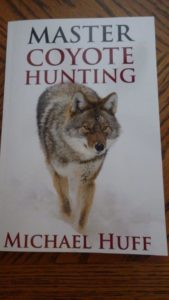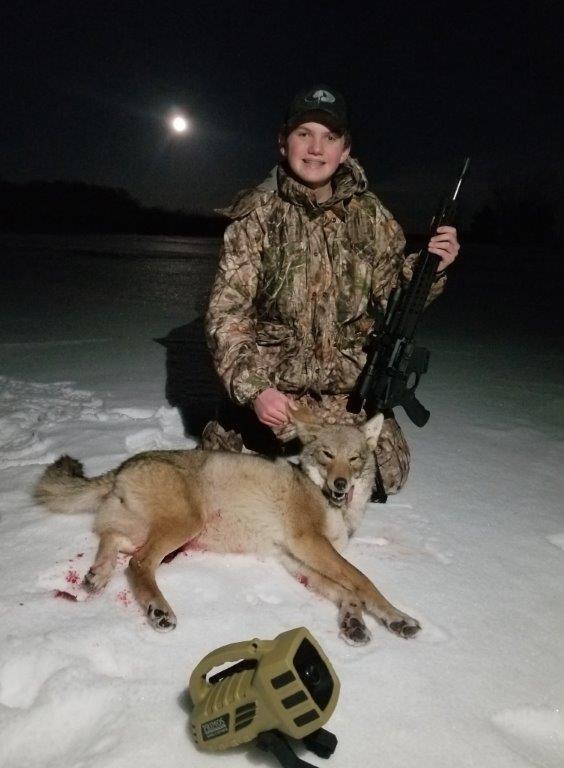 By: Tom Lounsbury.
By: Tom Lounsbury.
There is no doubt the coyote has become the star in regards to predator hunting in Michigan, and for a good reason because it is a highly prolific, adaptable and efficient predator. I’ve watched how its numbers have spread throughout our state during the last three decades (not to mention all of North America and now it has also crossed the Panama Canal and is presently invading South America) and it can even do well in an urban environment. A great book, “Master Coyote Hunting” by Michael Huff (available on Amazon for $19.95) is the best I have ever read about how-to on every facet of coyote hunting including calls, hunting arms/calibers, day and night hunting and even how to properly skin out a coyote. Huff is a fulltime licensed professional coyote hunting guide and operates Master Predator Hunting, LLC and certainly knows his stuff in this regard. I highly recommend his book, whether you are a seasoned predator hunter, or just starting out.
A fast growing winter pastime is hunting for fox (both red and gray), coyote, and where legal (refer to the MDNR Hunting Guide), bobcat. This is referred to today as “predator hunting”, but being old school, I still tend to call it “varmint hunting”, and whatever you wish to call it, Michigan offers excellent opportunities. Here in the Thumb, this means strictly for fox and coyote because the bobcat hunting zone is further north. Whatever method you use, predator hunting is extremely challenging, and a great way to enjoy the wintertime outdoors.
One of the oldest forms of predator hunting is using hounds, and this is a time-honored method steeped in tradition which goes back eons, with dogs and humans working constructively together. It is by no means a slam-dunk affair and a case in point is a hunt I was on near Rogers City. The hounds were pursuing a bobcat in a dense cedar swamp and I was thrilled to the core when I could hear the baying of the hounds coming my way as I intently watched the gaps in the cover as the sound of the dogs came ever closer. Pretty soon I spotted the dogs passing through the gaps as they went right on by me, and I never did see that bobcat. There is no question in my mind that it was like trying to spot a wisp of smoke whisking through the shadows. Such happens, and I do thoroughly enjoy listening to the hounds “singing”, which is always a major part of this atmosphere.
Using calls for luring predators into range is no doubt becoming quite popular these days, and electronic callers are clearly moving into the forefront in this regard. The electronic caller was pioneered by Johnny Stewart back when using old-style records and a portable record player (with a big funnel-like speaker) were the norm. This would allow recorded calling sequences to be used and hands to be free (for shooting purposes) and was definitely convenient for hunters not wishing to deal with mouth calls.
This in turn would eventually lead to more durable tape-cassette callers later followed by the present digital callers which are even more durable, versatile and compact than ever. A fact that I appreciate about an electronic caller is that the very authentic calling sequence (of which there is a wide and amazing variety to select from) can be placed away from the hunter per a remote system, which is certainly an asset when sharp-eyed predators are incoming and homing in on the calling.
For those wishing a true hands-on experience, mouth calls are still as popular as ever and I must admit they remain my favorite. A key to remember is that during frigid weather it pays to keep a spare mouth call or two tucked inside your coat, because the moisture from your breath can cause the call being used to freeze up and become useless until it is thawed out (been there, done that and the freeze up can happen real sudden like). One call I always have on hand is a rubber “squeaker” that simply requires squeezing, and it has more range than might be assumed, and truly sounds like a rodent in trouble. It is often the first call I use before trying others.
Whether using electronic or mouth calls, it never hurts to use a decoy that can add a little realism and a visual focus point for an incoming predator. When I’m using a rabbit in distress call, I often have a battery powered (and fuzzy) decoy that wobbles around on a stick, and it is an addition to the setup that doesn’t hurt. It also pays to remember that in regards to foxes and coyotes, they will often circle to the downwind side of the calling to assess the situation before committing.
I can remember when some hunters thought 15 minutes was enough time to call before moving on to another spot, but I’ve found it pays to stick to it longer, a gut feeling sort of thing. A major goal of my predator hunting trips up north (in the bobcat zone), is to successfully call in a bobcat, which seem to take forever to respond, a fact that I understand but thus far seem to never have enough patience to accomplish matters. I can remember calling for over an hour, and when I moved I discovered tracks in the snow of a bobcat that had finally decided to come in but I had spooked it.
When it comes to wintertime predator hunting/calling, I do appreciate a fresh snowfall that lets me know a predator making tracks is possibly still in the near vicinity, as this can up the odds, sometimes anyway. I can remember after one snowfall, spotting fresh coyote tracks crossing the road and leading into a local CRP grass field I had permission to hunt. I circled on foot along the outside of the tall grass to the downwind side of the field and sat down against an apple tree in the fencerow, and began calling.
My assumption was that the coyote would most likely come out of the tall grass and into the open field in front of me to scent matters downwind of my calling. I was using a mouth call to make “rabbit in distress” calls and was wailing away when I got that strange feeling something was right behind me. I slowly turned my head and looked right into the face of a large (at petting distance they all look large) coyote sitting quite calmly with its head cocked over to the side in that quizzical canine manner. I believe it wasn’t quite sure about how to tackle a rather oversized “rabbit”. This coyote had come straight in at high noon with a tailwind to the calling sequence (so much for assumptions).
Well folks, when you are that close to a critter, you can actually see the reality lights turn on in its eyes, and I’m pretty sure it can see them turning on for you too! The coyote performed a sudden twirl and disappeared back into the tall grass before I could turn enough to bring my rifle into play, and nearly choking on my mouth call didn’t help any either.
Calling and using lights and night vision optics (including laser sights) at night is quite legal for fox and coyote hunting and it has a steadily growing following of avid predator hunters. Several years ago, elevated stands (including tree-stands) became legal for daylight fox and coyote hunting in Michigan, but it is not legal for nighttime hunting. Hunter orange is now not required when a predator hunter is stationary, but must be worn when the hunter is travelling afoot. It is also not required for nighttime hunting (refer to the MDNR Hunting Guide for actual times).
A couple years ago #3 and # 4 buckshot became legal for nighttime fox and coyote hunting, as well as centerfire rifles (or handguns) .269 caliber or smaller were also included for nighttime hunting on private lands only. Prior to this only birdshot in shotguns and .22 caliber or smaller rimfire rifles could be used for nighttime fox and coyote hunting. For a fact, centerfire rifles (and buckshot too) has always been allowed for predator hunting in the Limited Firearms Zone during daylight hours.
When it comes to a calling setup, avoid sky-lining yourself and pick a location that breaks up your outline (a large tree trunk nearly the width of my shoulders works for me whether I’m sitting or standing). Camouflage clothing that matches the environment is invaluable and when it comes to snow, I’ve found both solid white and snow-camo work equally well. The same applies to the locally made Lucky’s portable ground blind (www.luckyshuntingblinds.com) specifically designed for predator hunting with its low profile.
One thing is for certain, predator hunting is a great way to spice up a long winter. It is quite literally “the other season” I look forward to each winter.

